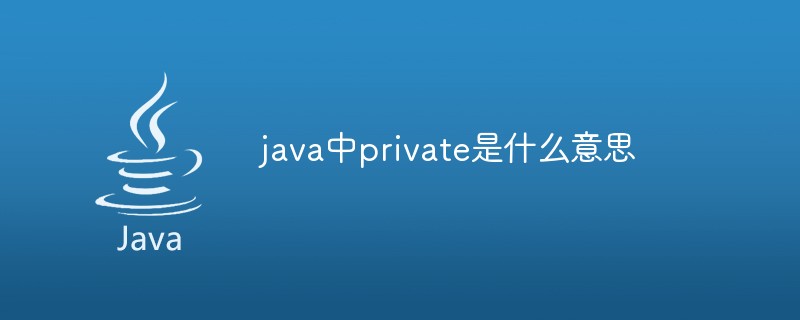What does private mean in java
In Java, private means "private" and is an access control modifier used to modify classes, properties and methods. Class members modified with private can only be accessed and modified by the methods of the class itself, and cannot be accessed and referenced by any other class (including subclasses of the class); therefore, the private modifier has the highest level of protection.

The operating environment of this tutorial: windows7 system, java8 version, DELL G3 computer.
Java Modifiers
The Java language provides many modifiers, which are mainly divided into the following two categories:
- Access modification Symbol
- Non-access modifier
Modifier is used to define classes, methods or variables, and is usually placed at the front of the statement. We use the following example to illustrate:
public class ClassName {
// ...
}
private boolean myFlag;
static final double weeks = 9.5;
protected static final int BOXWIDTH = 42;
public static void main(String[] arguments) {
// 方法体
}Access control modifier
In Java, you can use access control modifiers to protect classes, variables, and methods and constructor access. Java supports 4 different access rights.
default (i.e. default, write nothing): Visible within the same package, no modifiers are used. Use objects: classes, interfaces, variables, methods.
private (Private) : Visible within the same class. Use objects: variables, methods. Note: Classes (external classes) cannot be modified
##public: Visible to all classes. Used objects: classes, interfaces, variables, methods
protected: Visible to classes and all subclasses in the same package. Use objects: variables, methods. Note: Classes (external classes) cannot be modified.
| Current class | In the same package | Descendant classes (same package) | Descendant classes (different packages) | Other packages | |
|---|---|---|---|---|---|
public | YY | Y | Y | Y | |
protected | YY | Y | Y | N | |
default | YY | Y | N | N | |
private | YN | N | N | N |
The above is the detailed content of What does private mean in java. For more information, please follow other related articles on the PHP Chinese website!

Hot AI Tools

Undresser.AI Undress
AI-powered app for creating realistic nude photos

AI Clothes Remover
Online AI tool for removing clothes from photos.

Undress AI Tool
Undress images for free

Clothoff.io
AI clothes remover

AI Hentai Generator
Generate AI Hentai for free.

Hot Article

Hot Tools

Notepad++7.3.1
Easy-to-use and free code editor

SublimeText3 Chinese version
Chinese version, very easy to use

Zend Studio 13.0.1
Powerful PHP integrated development environment

Dreamweaver CS6
Visual web development tools

SublimeText3 Mac version
God-level code editing software (SublimeText3)

Hot Topics
 1376
1376
 52
52
 Square Root in Java
Aug 30, 2024 pm 04:26 PM
Square Root in Java
Aug 30, 2024 pm 04:26 PM
Guide to Square Root in Java. Here we discuss how Square Root works in Java with example and its code implementation respectively.
 Perfect Number in Java
Aug 30, 2024 pm 04:28 PM
Perfect Number in Java
Aug 30, 2024 pm 04:28 PM
Guide to Perfect Number in Java. Here we discuss the Definition, How to check Perfect number in Java?, examples with code implementation.
 Random Number Generator in Java
Aug 30, 2024 pm 04:27 PM
Random Number Generator in Java
Aug 30, 2024 pm 04:27 PM
Guide to Random Number Generator in Java. Here we discuss Functions in Java with examples and two different Generators with ther examples.
 Weka in Java
Aug 30, 2024 pm 04:28 PM
Weka in Java
Aug 30, 2024 pm 04:28 PM
Guide to Weka in Java. Here we discuss the Introduction, how to use weka java, the type of platform, and advantages with examples.
 Smith Number in Java
Aug 30, 2024 pm 04:28 PM
Smith Number in Java
Aug 30, 2024 pm 04:28 PM
Guide to Smith Number in Java. Here we discuss the Definition, How to check smith number in Java? example with code implementation.
 Java Spring Interview Questions
Aug 30, 2024 pm 04:29 PM
Java Spring Interview Questions
Aug 30, 2024 pm 04:29 PM
In this article, we have kept the most asked Java Spring Interview Questions with their detailed answers. So that you can crack the interview.
 Break or return from Java 8 stream forEach?
Feb 07, 2025 pm 12:09 PM
Break or return from Java 8 stream forEach?
Feb 07, 2025 pm 12:09 PM
Java 8 introduces the Stream API, providing a powerful and expressive way to process data collections. However, a common question when using Stream is: How to break or return from a forEach operation? Traditional loops allow for early interruption or return, but Stream's forEach method does not directly support this method. This article will explain the reasons and explore alternative methods for implementing premature termination in Stream processing systems. Further reading: Java Stream API improvements Understand Stream forEach The forEach method is a terminal operation that performs one operation on each element in the Stream. Its design intention is
 TimeStamp to Date in Java
Aug 30, 2024 pm 04:28 PM
TimeStamp to Date in Java
Aug 30, 2024 pm 04:28 PM
Guide to TimeStamp to Date in Java. Here we also discuss the introduction and how to convert timestamp to date in java along with examples.





